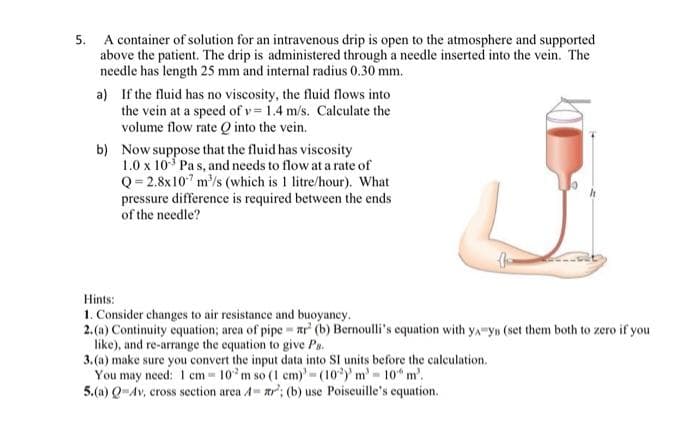5. A container of solution for an intravenous drip is open to the atmosphere and supported above the patient. The drip is administered through a needle inserted into the vein. The needle has length 25 mm and internal radius 0.30 mm. a) If the fluid has no viscosity, the fluid flows into the vein at a speed of v 1.4 m/s. Calculate the volume flow rate Q into the vein. b) Now suppose that the fluid has viscosity 1.0 x 10 Pas, and needs to flow at a rate of Q=2.8x10 m'/s (which is 1 litre/hour). What pressure difference is required between the ends of the needle? Hints:
5. A container of solution for an intravenous drip is open to the atmosphere and supported above the patient. The drip is administered through a needle inserted into the vein. The needle has length 25 mm and internal radius 0.30 mm. a) If the fluid has no viscosity, the fluid flows into the vein at a speed of v 1.4 m/s. Calculate the volume flow rate Q into the vein. b) Now suppose that the fluid has viscosity 1.0 x 10 Pas, and needs to flow at a rate of Q=2.8x10 m'/s (which is 1 litre/hour). What pressure difference is required between the ends of the needle? Hints:
University Physics Volume 1
18th Edition
ISBN:9781938168277
Author:William Moebs, Samuel J. Ling, Jeff Sanny
Publisher:William Moebs, Samuel J. Ling, Jeff Sanny
Chapter14: Fluid Mechanics
Section: Chapter Questions
Problem 129CP: Fluid originally flows through a tube at a rate of 100 cm3/s. To illustrate the sensitivity of flow...
Related questions
Question

Transcribed Image Text:5. A container of solution for an intravenous drip is open to the atmosphere and supported
above the patient. The drip is administered through a needle inserted into the vein. The
needle has length 25 mm and internal radius 0.30 mm.
a) If the fluid has no viscosity, the fluid flows into
the vein at a speced of v 1.4 m/s. Calculate the
volume flow rate Q into the vein.
b) Now suppose that the fluid has viscosity
1.0 x 10 Pas, and needs to flow at a rate of
Q = 2.8x10" m/s (which is 1 litre/hour). What
pressure difference is required between the ends
of the needle?
Hints:
1. Consider changes to air resistance and buoyancy.
2. (a) Continuity equation; area of pipe = ar (b) Bernoulli's equation with yA ys (set them both to zero if you
like), and re-arrange the equation to give Pe.
3.(a) make sure you convert the input data into SI units before the calculation.
You may need: 1 cm 10 m so (1 cm)'-(10)' m' 10 m'.
5.(a) Q-Av, cross section area A ar; (b) use Poiseuille's equation.
Expert Solution
This question has been solved!
Explore an expertly crafted, step-by-step solution for a thorough understanding of key concepts.
Step by step
Solved in 2 steps with 2 images

Knowledge Booster
Learn more about
Need a deep-dive on the concept behind this application? Look no further. Learn more about this topic, physics and related others by exploring similar questions and additional content below.Recommended textbooks for you

University Physics Volume 1
Physics
ISBN:
9781938168277
Author:
William Moebs, Samuel J. Ling, Jeff Sanny
Publisher:
OpenStax - Rice University

College Physics
Physics
ISBN:
9781938168000
Author:
Paul Peter Urone, Roger Hinrichs
Publisher:
OpenStax College

Principles of Physics: A Calculus-Based Text
Physics
ISBN:
9781133104261
Author:
Raymond A. Serway, John W. Jewett
Publisher:
Cengage Learning

University Physics Volume 1
Physics
ISBN:
9781938168277
Author:
William Moebs, Samuel J. Ling, Jeff Sanny
Publisher:
OpenStax - Rice University

College Physics
Physics
ISBN:
9781938168000
Author:
Paul Peter Urone, Roger Hinrichs
Publisher:
OpenStax College

Principles of Physics: A Calculus-Based Text
Physics
ISBN:
9781133104261
Author:
Raymond A. Serway, John W. Jewett
Publisher:
Cengage Learning

College Physics
Physics
ISBN:
9781305952300
Author:
Raymond A. Serway, Chris Vuille
Publisher:
Cengage Learning